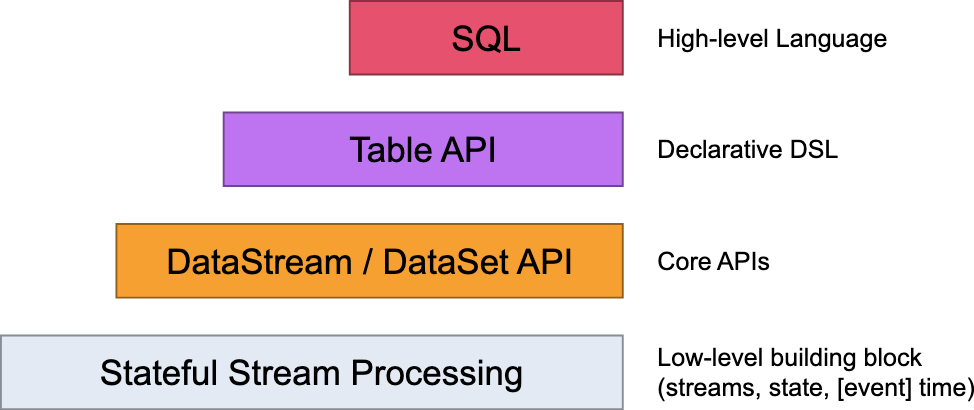第四章中介绍了 DataStream API 以及 DataSet API 的入门案例,本章开始介绍 Table API 以及基于此的高层应用 Flink SQL 的基础。
5.1 Flink Table & SQL 基础知识
Flink 提供了两个关系API——Table API 和 SQL——用于统一的流和批处理。Table API 是一种针对Java、Scala和Python的语言集成查询API,它允许以非常直观的方式组合来自关系运算符(如选择、筛选和联接)的查询。Flink的SQL支持基于Apache Calcite,后者实现了SQL标准。无论输入是连续的(流式)还是有界的(批处理),在任一接口中指定的查询都具有相同的语义并指定相同的结果。
Table API和SQL接口与彼此以及Flink的DataStream API无缝集成。您可以轻松地在所有API和基于它们构建的库之间切换。
SQL是数据分析中使用最广泛的语言。Flink的Table API和SQL使用户能够用更少的时间和精力定义高效的流分析应用程序。此外,Flink Table API和SQL得到了有效的优化,它集成了大量的查询优化和优化的运算符实现。但并非所有优化都是默认启用的,因此对于某些工作负载,可以通过启用某些选项来提高性能。
5.2 DataStream / DataSet API & Table API & SQL 之间的关系
如下图所示,现在从下往上我们逐层介绍。

- 最低级别的抽象只是提供有状态和及时的流处理。它通过Process Function嵌入到DataStream API中。它允许用户自由处理来自一个或多个流的事件,并提供一致的容错状态。此外,用户可以注册事件时间和处理时间回调,使程序能够实现复杂的计算。
- 在实践中,许多应用程序不需要上面描述的低级抽象,而是可以根据核心API进行编程:DataStream API(有界/无界流)。这些流畅的API为数据处理提供了通用的构建块,如各种形式的用户指定的转换、联接、聚合、窗口、状态等。在这些API中处理的数据类型在各自的编程语言中表示为类。
低级别的Process Function与DataStream API集成在一起,从而可以按需使用低级别的抽象。数据集API在有界数据集上提供了额外的基元,如循环/迭代。
- Table API是一个以表为中心的声明性DSL,表可以是动态变化的表(当表示流时)。Table API遵循(扩展的)关系模型:表附加了一个模式(类似于关系数据库中的表),API提供了类似的操作,如选择、项目、联接、分组传递、聚合等。Table API程序以声明的方式定义了应该执行的逻辑操作,而不是确切地指定操作代码的外观。虽然Table API可以通过各种类型的用户定义函数进行扩展,但它的表达能力不如Core API,使用起来更简洁(编写的代码更少)。此外,Table API 程序还通过一个优化器,该优化器在执行之前应用优化规则。
可以在表和数据流/数据集之间无缝转换,允许程序将表API与数据流和数据集API混合。
- Flink提供的最高级别抽象是SQL。这种抽象在语义和表达上都类似于Table API,但将程序表示为SQL查询表达式。SQL抽象与Table API密切交互,SQL查询可以在Table API中定义的表上执行。
5.3 Flink Table API 添加依赖
在前面的例子中,我们已经添加了 flink-clients 核心依赖,现在使用Table API 时,需要额外添加两个依赖,如下所示:
org.apache.flink flink-table-api-java-bridge_${scala.binary.version} ${flink.version} org.apache.flink flink-table-planner_${scala.binary.version} ${flink.version} 其中,${flink.version} 为 1.14.6 ,而 {scala.binary.version} 为 2.11。
5.4 Flink Table API / SQL 第一个例子 StreamSQLExample
这个例子大概可以理解为:总共两个订单,每个订单里包含三条记录,总共六条记录。形成一张表,然后根据订单中 product 字段进行 UNION 操作,并把最终结果打印。
import org.apache.flink.streaming.api.datastream.DataStream; import org.apache.flink.streaming.api.environment.StreamExecutionEnvironment; import org.apache.flink.table.api.Table; import org.apache.flink.table.api.bridge.java.StreamTableEnvironment; import java.util.Arrays; /** * 摘录自 flink 1.14.6 源码例子 * @author Smileyan */ public class StreamSQLExample { public static void main(String[] args) throws Exception { // set up the Java DataStream API final StreamExecutionEnvironment env = StreamExecutionEnvironment.getExecutionEnvironment(); // set up the Java Table API final StreamTableEnvironment tableEnv = StreamTableEnvironment.create(env); final DataStreamorderA = env.fromCollection( Arrays.asList( new Order(1L, "beer", 3), new Order(1L, "diaper", 4), new Order(3L, "rubber", 2))); final DataStream orderB = env.fromCollection( Arrays.asList( new Order(2L, "pen", 3), new Order(2L, "rubber", 3), new Order(4L, "beer", 1))); // convert the first DataStream to a Table object // it will be used "inline" and is not registered in a catalog final Table tableA = tableEnv.fromDataStream(orderA); // convert the second DataStream and register it as a view // it will be accessible under a name tableEnv.createTemporaryView("TableB", orderB); // union the two tables final Table result = tableEnv.sqlQuery( "SELECT * FROM " + tableA + " WHERE amount > 2 UNION ALL " + "SELECT * FROM TableB WHERE amount < 2"); // convert the Table back to an insert-only DataStream of type `Order` tableEnv.toDataStream(result, Order.class).print(); // after the table program is converted to a DataStream program, // we must use `env.execute()` to submit the job env.execute(); } // ************************************************************************* // USER DATA TYPES // ************************************************************************* /** Simple POJO. */ public static class Order { public Long user; public String product; public int amount; // for POJO detection in DataStream API public Order() {} // for structured type detection in Table API public Order(Long user, String product, int amount) { this.user = user; this.product = product; this.amount = amount; } @Override public String toString() { return "Order{" + "user=" + user + ", product='" + product + '\'' + ", amount=" + amount + '}'; } } } 
5.5 Flink Table API / SQL 第二个例子 WordCountSQLExample
这个例子更加简单,因为连 union 的操作都已经省去了,直接从一个表中进行SELECT。
import org.apache.flink.table.api.EnvironmentSettings; import org.apache.flink.table.api.TableEnvironment; /** * * @author Smileyan */ public class WordCountSQLExample { public static void main(String[] args) { // set up the Table API final EnvironmentSettings settings = EnvironmentSettings.newInstance().inBatchMode().build(); final TableEnvironment tableEnv = TableEnvironment.create(settings); // execute a Flink SQL job and print the result locally tableEnv.executeSql( // define the aggregation "SELECT word, SUM(frequency) AS `count`\n" // read from an artificial fixed-size table with rows and columns + "FROM (\n" + " VALUES ('Hello', 1), ('Ciao', 1), ('Hello', 2)\n" + ")\n" // name the table and its columns + "AS WordTable(word, frequency)\n" // group for aggregation + "GROUP BY word") .print(); } }
5.6 参考资料
https://github.com/apache/flink/tree/release-1.14.6
https://nightlies.apache.org/flink/flink-docs-release-1.14/docs/concepts/overview/
5.7 总结
第四章介绍了DataStream API和DataSet API的入门案例,而第五章则开始介绍了Table API以及基于其上的高层应用Flink SQL的基础知识。
在5.1中,阐述了Flink提供的两个关系API——Table API和SQL,用于统一流和批处理。无论是处理连续的流数据还是有界的批处理数据,在这两个接口中指定的查询具有相同的语义和结果。Table API和SQL接口与DataStream API无缝集成,用户可以轻松在它们之间切换。
5.2详细描述了DataStream、DataSet、Table API以及SQL之间的关系。从最低级别的抽象开始,介绍了DataStream API的Process Function,然后是DataStream API和DataSet API的一般构建块,最后到以表为中心的声明性DSL——Table API。最高级别的抽象是SQL,与Table API密切交互,允许通过SQL查询表达式执行操作。
在5.3中,介绍了Flink Table API的添加依赖,以及相应的Maven配置。
最后,在5.4和5.5中给出了两个Flink Table API / SQL的例子。StreamSQLExample展示了使用Table API和SQL进行流处理的例子,而WordCountSQLExample则展示了一个简单的批处理Flink SQL作业。
总体而言,本章深入介绍了Flink的Table API和SQL,以及它们与DataStream和DataSet API的关系,为使用Flink进行流和批处理提供了全面的基础知识。
Smileyan
2023.12.18 23:14
猜你喜欢
网友评论
- 搜索
- 最新文章
- 热门文章
